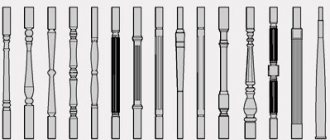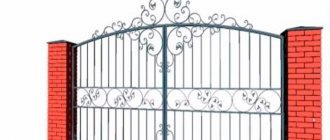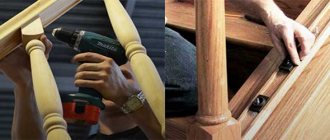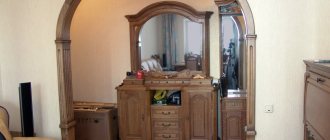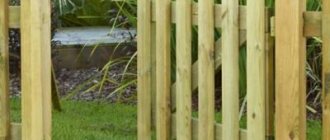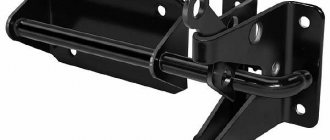Beautiful and reliable wooden balusters can be purchased complete with the staircase structure. Experienced carpenters advise trying to make such parts with your own hands.
Work on turning or milling shapes will require a lathe or milling woodworking machine, a set of hand tools and experience in performing such operations.
Methods for making wooden balusters
According to the manufacturing method, wooden decorations for stairs and railings are divided into 3 main groups.
| Classification | Short description |
| Turned on a lathe | They are made of round shape from wood with various decorations. Not the most difficult option, but it requires the ability to work with cutters of various shapes. |
| Milled | Depending on the sketch, round or rectangular shapes of staircase elements are made. On such balusters you can create a unique design using longitudinal and transverse screw threads or decorate them with other patterns. |
| Balusters with elements of manual or mechanical wood carving | For the production of industrial parts, computer-controlled machines are used. A home handyman will need experience in performing such work and a lot of time. Therefore, stairs or railings with such elements are quite rare. |
The main purpose of balusters and support posts is to create a rigid and safe staircase structure. Additionally, they can serve as decorative elements, but such work requires skill and experience in woodworking.
Design features and types of wooden balusters
To suit the design decision, you can make wooden balusters of any shape and texture. However, in the design of support posts for filling fences, there are three parts:
- base - the bottom of the column;
- body – the middle part, usually made with decorative elements;
- the upper support part, on which the fence handrail is attached, is symmetrical to the base.
Flat balusters: step-by-step instructions
Flat supports are easiest to make yourself. Their production does not require complex equipment. Skillfully made supports have an attractive appearance. They can decorate any interior.
Step 1. The first stage of work is devoted to preparing the materials and tools necessary for the manufacture of balusters: jigsaw, paper, marker, scissors, ruler, sandpaper or sanding machine, dry boards or plywood.
Step 2. For ease of work, you need to transfer the contours of the future product onto the workpiece. You can stick the pattern itself directly on top. After you have cut out all the shapes, you need to sand the surface.
Step 3. A thin layer of wood is removed, all corners are ground down, smooth and neat curves are created. It is best to sand flat balusters with your own hands using a special tool or a screwdriver attachment.
Curly balusters made of wood
Making volumetric balusters with your own hands is much more difficult than flat ones. Here you will need more professional equipment, carving and drawings. The most primitive option is to cut a beam with a round or square cross-section into fragments of the required length. A more progressive option is chiseled models.
For them, you can use a manual milling machine or a regular drill. The latter must be secured in a stable position so that the nozzle is fixed from below and normal access is ensured.
The production of balusters on a machine is carried out in the following sequence:
- Securing a wooden workpiece on a machine often requires making holes at the ends. Fixation must be done strictly in the center to obtain an even, symmetrical product.
- The wooden block is first ground with a semicircular chisel to cut off the edges of the workpiece. The process of turning a baluster from a block
- Finishing – the workpiece is turned with a rake at an angle of 45 degrees.
- Turning figured parts according to the drawing using chisels manually or on a machine. Having selected the cutter needed for the element using the template, it is placed at an angle to the axis of rotation and the workpiece is sharpened to the required depth and shape. Then they change the cutter and proceed to the next section of the rack.
- Finishing – grinding and polishing.
- Decorative treatment - impregnation of the column with special means, painting or varnishing.
Variety of shapes
A beautiful baluster, regardless of whether it is wooden or plastic, will decorate the stairs in the house. The design of the decorative stand is conventionally divided into several parts:
- the lower part, which is attached to the step or floor covering - the base;
- the central segment with decorations and carvings is the body;
- The upper support is designed to connect to the railing and increase the area of the joint.
Important! When making or purchasing ready-made decorative parts, you need to decide on their length. The size depends on the height of the staircase railing, but the balusters should have a small margin in length to make corner cuts when joining with the overall structure.
According to their shape, wooden products are divided into cylindrical, ellipsoidal, rectangular and figured.
A cylindrical baluster made of wood is a classic type of product on which various decoration and decorative elements are made. The pattern consists of various differences in thickness. Such parts can only be made with special cutters on a lathe.
Elliptical or rectangular balusters are made according to a sketch using a jigsaw. Various designs are made on the body using a manual milling cutter or CNC machines.
Figured stands with elements of hand-carved wood are made from expensive types of wood (hard fruit or exotic).
Selecting material for balusters
Balusters are special holding posts that are installed between the steps and the handrails. A wide variety of materials can be used to make such supports. But the most popular are carved balusters made of wood.
Visually, the racks can be divided into three parts:
- The base of the support or pint is attached to the balusters or step.
- The central part of the rack performs protective functions.
- Handrail support . This part of the baluster must be made with an allowance so that it remains possible to adjust the height of the railing.
For the manufacture of supports, it is very important to choose the material. The performance characteristics of the products will depend on this.
What type of wood to choose
To avoid future deformation of the structure, it is recommended that steps, railings and stair racks be made from the same wood. You should choose hard wood species.
Larch.
This tree produces durable products of brown or red-brown color. Thanks to the special composition of larch resin, balusters and railings made from it will only become stronger over time. The wood is not subject to rotting, however, cracks may occur during drying.
Pine.
The color of pine balusters can range from light yellow to yellowish-red. Pine lends itself well to sanding and is easy to process with cutting tools. Products made from it are not affected by fungus and can withstand temperature changes.
Birch.
Products made from birch can be easily painted and given the appearance of valuable tree species. Birch has good viscosity, but average hardness and density. It is easy to process, polish and glue. However, wood is susceptible to rot and may crack when dried. That is why it is rarely used for the manufacture of railings and balusters.
Ash.
The wood has a beautiful structure; when steamed, it bends well and warps little. Products made from it are yellowish in color with light or dark stripes. The structure of the wood is dense, elastic and heavy. Ash supports and railings will last a long time and can withstand significant loads.
Beech.
Wood is used to imitate valuable species. Products made from beech bend and process well. To extend the life of paint and varnish coatings, balusters and railings can be impregnated with various compounds. However, beech products should only be installed in rooms with low humidity, as the wood is susceptible to rotting.
Oak.
Oak products have a light brown or dark brown color. They are characterized by strength, wear resistance and resistance to decay. Oak railings and balusters will not warp or crack. The dense structure of wood can be used to make curved elements and very small parts.
Supports can also be made from more expensive and rare tree species. If you can’t buy them in the store, you will need to contact the manufacturer directly and place an order.
Is it possible to do it yourself?
It is possible to make wooden decorations for the stairs with your own hands, but this will require knowledge and experience in working with a woodworking machine, as well as a full set of cutters. Simple wooden posts with slightly rounded corners don't require much expertise but won't add any appeal to a staircase or railing. They are suitable for a country house or temporary building.
A staircase with cylindrical turned lintels will look more attractive, but making the balusters identical on a simple lathe is a difficult task that only experienced carpenters can do. If you have a supply of bars, time and desire, then any craftsman who knows how to handle wood can handle the job.
Advice! You can cut a flat type of baluster from a board according to a template, process the edges with a hand router, sand and stain the parts with stain.
Flat, simple parts are easier to attach to the overall staircase structure, but during manufacturing it is important to take into account the width of the steps.
Why make balusters yourself
Homemade balusters can come in a variety of shapes
Of course, you can purchase ready-made balusters, but this does not suit everyone:
- Products offered on the construction market may not be suitable in design and may not fit into the style of the staircase, interior or facade.
- Finished balusters may not fit the dimensions of the fence or staircase.
- I want the staircase to be original, exclusive and not like others.
- The price for making to order will most likely be high, or the deadlines for its implementation may also not be satisfactory.
- Making something with your own hands for your home is always a pleasure.
Mounting methods
Regardless of the design, balusters for stairs are secured in three main ways.
On a tenon or dowel
This method will allow you to quickly install the staircase structure. Furniture and other wooden structures are assembled using cylindrical dowels. For better fixation, wooden parts are additionally glued with PVA wood glue or other compounds. Holes are drilled on the staircase structure and at the end of the balusters and connected using wooden cylinders.
The disadvantage of this method is that the connection is permanent, and if it breaks, you will have to drill out the remaining dowels and repeat the assembly. To fix a fault in the structure, you will need to completely remove the railing and make repairs, so this type of connection is rarely used.
On a stiletto heel
It is possible to attach balusters to a stud in structures of any complexity. This is one of the most popular ways to assemble a stair railing. A hole along the length is drilled in the baluster into which a mounting pin is inserted. When working, mark the fastening points on the steps or deck boards, and drill larger holes for free passage of the studs.
A groove is drilled on the side of the end part of the step in the center of the hole to install the fastening nut. Before assembly, for better fixation, a layer of glue is applied to the parts, tightly connected along the marking contour and the thread of the metal rod is tightened. It is more difficult to secure the fence to the railing. To do this, it is recommended to use special screw-in hinges. With the help of such a device, the structure is easily and quickly connected; just press the handrail tightly and secure it with a nut.
Self-tapping screws
The most universal method of installing staircase structures and railings to steps and strings is using self-tapping screws. In this case, several assembly options are used:
- with fastening through balusters;
- using a base plate;
- using direct fixation of parts and assemblies.
Each method involves fastening wooden balusters through steel plates that securely hold the segment. This is due to the use of 4 support points (screws). With the help of a decorative detail of the baluster it is possible to hide the attachment point.
On a staircase that is not equipped with risers, the parts are fastened together on the underside without disturbing the overall appearance of the structure. To secure the racks to the bowstring, rotating elements are used, which allow you to fix the balusters to the side of the stringer. Using this technique, it is possible to expand the usable area of the steps by placing the structure at the end of the staircase or fence.
Advice! When trimming and adjusting balusters, it is important to prevent chips and cracks on decorative parts. To do this, you will need to wrap the ends with tape or tape. After this, when trimming with a hacksaw or jigsaw, the likelihood of chipping is reduced to zero.
Dimensions and prices for blanks for balusters and initial posts
| Size (mm) | Price | |||||||
| Oak cat. "A" | Oak cat. "E" | Ash cat. "A" | Ash cat. "E" | Larch cat. "A" | Larch cat. "E" | Beech cat. "A" | Beech cat. "E" | |
| 50x50x900 | 550 rub. | — | — | — | 400 rub. | 510 rub. | — | 450 rub. |
| 60x60x900 | 730 rub. | — | — | — | — | — | — | — |
| 80x80x1200 | 2040 rub. | — | 1390 rub. | — | 1080 rub. | 1140 rub. | — | — |
| 100x100x1200 | 2750 rub. | — | 2050 rub. | — | 1560 rub. | 1620 rub. | — | — |
| 120x120x1200 | 3300 rub. | — | — | — | — | — | — | — |
Recommendations for installing balusters
Before starting work, the master needs to remember the simple rules for installing the staircase structure:
- maximum distance between balusters 150 mm;
- For any assembly methods, be sure to use a layer of wood glue - this will protect against unpleasant squeaking when loosening threaded connections and will increase the reliability of the connection;
- maximum railing height 900 mm;
- installation begins with the installation and fastening of the outer support pillars of the span;
- At the ends of the balusters, holes are pre-drilled, the diameter of which is 2–3 mm smaller than that of self-tapping screws and studs.
You can make balusters yourself, but you need skill in working with woodworking machines and performing painting work on wood. Simple flat stands can be made by any home craftsman who knows how to work with a jigsaw and a grinding machine. We recommend that you first practice and make a simple fence on a terrace or in a garden gazebo, and then start building a complex staircase structure.
Prices and sizes of initial “Box” posts
| Type | Size (mm) | Price |
| №1 | Initial column “Box” (not hollow) No. 1, larch, 135x135x1150 | 6500 rub. |
| Initial column “Box” (not hollow) No. 1, oak, 140x140x1250 | 9500 rub. | |
| №2 | Initial column “Box” (not hollow) No. 2, larch, 135x135x1150 | 6500 rub. |
| Initial column “Box” (not hollow) No. 2, oak, 140x140x1250 | 9500 rub. | |
| Initial post “Box” (not hollow) No. 2, pine, 135x135x1150 | 5000 rub. | |
| №3 | Initial column “Box” (not hollow) No. 3, oak, 140x140x1250 | 9500 rub. |
| Initial column “Box” (not hollow) No. 3, oak, 160x160x1250 | 10500 rub. | |
| №3 | Initial column “Box” (not hollow) No. 3, larch, 135x135x1150 | 6500 rub. |
| Initial column “Box” (not hollow) No. 3, larch, 155x155x1250 | 9200 rub. | |
| №3 | Initial post “Box” (not hollow) No. 3, pine, 135x135x1150 | 5000 rub. |
| Initial post “Box” (not hollow) No. 3, pine, 155x155x1250 | 6000 rub. | |
| №4 | Initial column “Box” (not hollow) No. 4, larch, 135x135x1150 | 6500 rub. |
| Initial column “Box” (not hollow) No. 4, oak, 140x140x1250 | 9500 rub. | |
| Initial post “Box” (not hollow) No. 4, pine, 135x135x1150 | 5000 rub. | |
| Platform for the starting post | To order , Pine, On a pole: 80x80; 100x100; 120x120; 150x150; 200x200; etc. Thickness: 18; 28; 40. | from 300 rub. |
| To order , Larch, On a pole: 80x80; 100x100; 120x120; 150x150; 200x200; etc. Thickness: 18; 28; 40 | from 450 rub. | |
| To order , Oak, On a pole: 80x80; 100x100; 120x120; 150x150; 200x200; etc. Thickness: 20; thirty; 40. | from 600 rub. |
How to choose the right balusters?
When choosing supports for fences of various designs, various factors are used. Among them:
- appearance;
- price;
- size;
- performance material.
When ordering fencing installations from specialized organizations, they produce structural elements from wood of the same species. The same principle must be followed when installing fencing yourself. You cannot install balusters made of oak, and railings made of alder or larch. The purchased products must have the correct geometric dimensions. They should not have:
- defects;
- deformations;
- blue on the surface;
- emptiness inside.
You should not buy products with fallen knots or made from raw wood.
Prices for various types of balusters
Balusters
